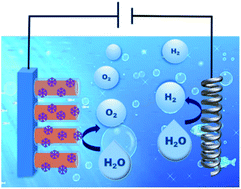Improvement of the water oxidation performance of Ti, F co-modified hematite by surface modification with a Co(salen) molecular cocatalyst†
Abstract
A promising integral modification method to solve the correlative drawbacks of hematite photoanodes from the bulk to the surface was proposed. In this study, a new system was developed by combining Ti-doping and F-treatment in hematite nanorods, and finally modified with Co(salen) as a cocatalyst. Ti-Doping dramatically enhanced the current density owing to the increase of conductivity, while F-treatment lowered the onset potential by forming F–Ti moieties on the surface of hematite nanorods. The loading of Co(salen) on the surface of hematite nanorods as a molecular catalyst further improved the photoelectrochemical performances of both the photocurrent and the onset potential. This complex structure of F–Ti-Fe2O3/Co(salen) acquired a current density of 3.02 mA cm−2 at 1.23 V vs. RHE under illumination, which was 6 times higher than that of pristine hematite. Compared to aggregated CoOx, which was derived from thermally treated Co(salen), molecularly dispersed Co(salen) was an efficient cocatalyst because its molecular structure was fluffy, which provided more active reaction sites and promoted the water oxidation reaction kinetics.



 Please wait while we load your content...
Please wait while we load your content...